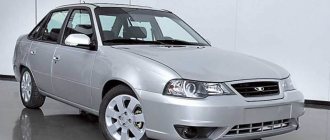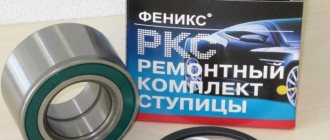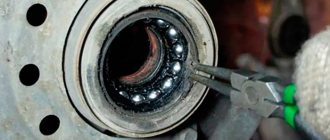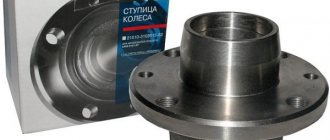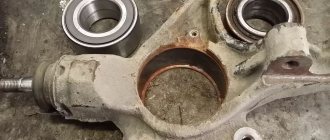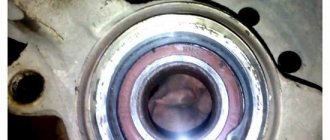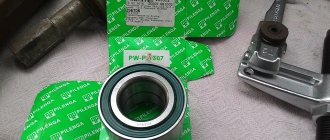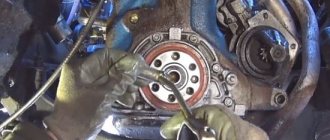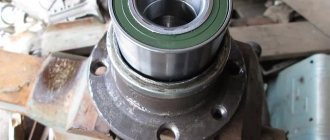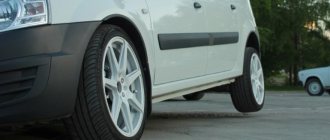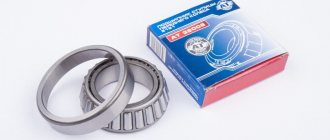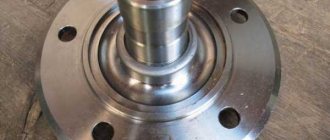Purpose of the wheel bearing
The front wheel bearing is used to allow the Lada Largus wheel to rotate freely.
Manufacturers use high-strength metal as the basis for this product. This allows the hinge to withstand increased loads. Over time, this part experiences natural wear and tear, resulting in the need for replacement. Also, improper operation can contribute to the damage of the hinge, then the bearing needs to be replaced. Vigilance should be exercised in terms of timely diagnosis of the condition of this important component of the chassis, which has a significant impact on ensuring the overall safety of people present in the vehicle. To avoid emergency situations, timely replacement of the bearing will be a truly effective measure. It is important to carry out this repair measure when the first signs of damage appear.
Shown here is a view of the front wheel bearing of the Lada Largus chassis.
Bearing installation
Before installing a new bearing, clean the mounting hole in the steering knuckle and the groove for the retaining ring. Using a needle file, we clean out the nicks from the chisel on the hub.
Before pressing the bearing, we insert the mounting ring of the wheel speed sensor into the hole of the steering knuckle (with the paws centering the ring, inside the knuckle).
We orient the ring in the hole of the fist so that the speed sensor holder on ring 1 (Figure 13) is located in the groove of fist 2 (for clarity, shown on the assembled hub assembly).
After installing the cup puller screw with the support washer, insert a new bearing into the hole in the knuckle.
On a vehicle with ABS, the bearing should be installed so that its dark-colored protective washer (made of magnetic material) faces the wheel speed sensor mounting ring.
Figure 15 shows the details of the hub assembly.
We press in the bearing, applying force through the puller cup to the end of the outer ring of the bearing, while the puller washer should rest on the steering knuckle (Figure 16).
After pressing the bearing, install a retaining ring in the groove of the knuckle. Then we press the hub into the bearing.
When pressing the hub, the puller cup should rest on the end of the inner ring of the bearing (Figure 17).
We carry out further assembly and installation of the hub unit in the reverse order.
- How to replace the front shock strut of Lada Largus
- How to remove the steering knuckle of the Lada Largus suspension
Replacing the front wheel bearing of Lada Largus
Page 1 of 3
We replace the hub bearing when play appears. Bearing wear can be determined by increased noise when the vehicle is moving.
The operations for replacing a wheel bearing with and without ABS are similar. The only difference is the installed speed sensor in the steering knuckle.
We prepare the car for the job.
We install the car on a viewing hole or lift.
In order to unscrew the hub nut, we install stops under the wheels.
Usually the hub nut is tightened with great force, so you need an assistant to press the brake while unscrewing the nut.
Using a 32 socket (Fig. 1), unscrew the wheel hub bearing nut.
We hang and remove the wheel.
Remove the front wheel speed sensor (if installed).
Remove the brake disc.
Using a TorxT-30 wrench, unscrew the three screws securing the brake shield to the steering knuckle and remove the shield.
Disconnect the tie rod end from the steering knuckle
We remove the ball joint pin from the steering knuckle hole
Disconnect the shock absorber strut from the steering knuckle
Remove the steering knuckle (Figure 2) assembled with the hub from the splined shank of the outer wheel drive joint housing.
When removing the steering knuckle from the drive, you must try not to pull the drive shaft out of the CV joint or gearbox.
We rest the steering knuckle on the jaws of the vice (Figure 3).
By striking the end of the hub through a mandrel or head of a suitable size
We press out the hub. In this case, the inner bearing ring, located closer to the hub flange, remains on the hub.
Use a screwdriver to pry off the protective washer covering the bearing seal.
We remove the washer.
We clamp the hub flange in a vice.
avtomechanic.ru
Causes of malfunction
The front wheel bearing is a fairly strong part in its structure, and in order to prematurely fail it requires the application of truly significant efforts. With adequate operation, this suspension component exhibits enviable survivability, without annoying the owner with hints of its malfunction. Only natural wear and tear over a long run can affect the condition of this component.
If we touch on the reasons for the failure of the bearing we are considering, we can highlight several aspects:
- Increased mileage. Bearing failure in a Lada Largus can make itself felt after a mileage of 60 to 110 thousand km. This parameter is individual for each model. It is also directly influenced by operating conditions. The occurrence of a breakdown will be indicated by a specific crunching sound coming from the front wheel area. Almost every driver knows about this sound accompaniment of a malfunction.
- Loss of tightness. The separator part of the bearing is covered with plastic casings. They allow the lubricant to be retained and reduce the amount of friction that occurs when the internal race of the product rotates together with the hub. Over time, these protective elements become unusable, after which dirt penetrates into the working area, washing away the lubricant. Soon a hum appears, which hints to the owner that the node needs to be diagnosed.
- Extreme riding. Broken roads are not the ally of wheel bearings. Regular driving of the Lada Largus over potholes mercilessly damages these seemingly reliable suspension elements.
- Incorrect installation. An incorrectly replaced bearing will not perform its functions and will soon require another replacement.
Malfunctions and their diagnosis
Car owners remember about these parts hidden from view in the hub only when problems begin and the wheel makes extraneous sounds when moving. If the issue is not natural wear and tear, then the cause may be errors during replacement or the use of parts of questionable manufacture. Such bearings are not so easy to deform or break. To achieve their destruction, you need to try hard. Typically, this element rarely gives a car enthusiast a reason to visit special service stations.
Why parts fail
| Factors | Characteristics |
| Long mileage. | Depending on the quality of the components, the first signs of the need for replacement may appear at mileage from 60,000 km to 110,000 km. This parameter may differ for products from different manufacturers. |
| Incorrect operation. | Evidence of problems with the Largus wheel bearing will be a characteristic crunch when the wheel rotates, which can be difficult to confuse with another malfunction. Even if a car enthusiast is a novice and does not understand the structure of a car, he will immediately understand this sound. |
| Violation of tightness. | The separator is closed with plastic covers. Firstly, these linings retain lubricant inside, and secondly, they reduce the friction force that occurs during rotation of the inner race and hub. With natural wear and tear, such a plastic casing loses its original tightness. Dust and dirt can get inside the bearing. At the same time, the lubricant loses its properties. The friction force increases, the parts begin to heat up. Ultimately, a characteristic hum appears from the lack of the proper amount of lubrication. He will inform the driver that the bearing needs to be changed as soon as possible before it begins to deteriorate. |
| Aggressive driving style. | Extreme rides, fast acceleration and sharp braking also do not have a positive effect on the service life of wheel bearings. And if you add to this frequent driving over bumps and potholes at high speed, then these reliable and durable suspensions will fail much earlier than required by regulations. |
Unskilled replacement work can also cause an early breakdown. If the car owner incorrectly installs the wheel bearing on his own or if incompetent car service technicians do it, you should not hope for a long service life of this part.
Even a high-quality model, if installed incorrectly, will not work correctly and will not perform its functions, and will fail very quickly.
Signs of Problems
To correctly determine the faulty wheel bearings of the Lada Largus, there are several simple but guaranteed symptoms of problems with this device. Firstly, there is a dry crunch coming from the wheel. This sound always appears when the hub bearings fail. The noise is caused by destroyed rotating elements of the product; their cage is already broken and a crunching sound occurs due to uneven placement. It is impossible to miss this moment, because the sound is clearly audible not only outside, but also inside the car when driving. If such noise occurs, the bearing must be replaced immediately.
The second symptom is the occurrence of strong vibration. When the wheel bearing wears out, vibration is transmitted to the body and is clearly felt on the steering wheel. This sign indicates complete wear of the holder: the destruction of the spherical elements has begun, which can at any time lead to the wheel jamming. It should be changed immediately.
The third, but at the same time indirect sign, is the car pulling to the side when driving. Of course, this could be incorrect wheel alignment, imbalance, etc. But it happens that such a sign also indicates that the lubrication in the bearing is not working and there is a slight force when the spherical elements rotate, which causes some kind of stopper.
Many motorists say in all seriousness that they can continue to drive with a faulty wheel bearing, and moreover, drive at high speeds. You can’t do something like this, it’s simply life-threatening. If a wheel gets stuck while moving, it will stop abruptly. It is not difficult to guess what will happen when, at high speed, one of the four wheels suddenly becomes motionless. In the best case, the car will suddenly be thrown onto the side of the road, and in the worst, into the oncoming lane under moving traffic, hence the accident. There are cases where a wheel jam caused the car to overturn.
If the bearing is about to fall apart, then you can drive to the nearest service station or garage, but at a speed of no more than 40 km/h, otherwise you risk getting into a serious accident.
Troubleshooting
In addition to the above symptoms indicating a faulty wheel bearing, you can carry out a number of checks to ensure the accuracy of the diagnosis. This is very easy to do and can even be done in a parking lot.
The process looks like this.
- The car is placed on a flat asphalt surface.
- With both hands you need to grab the top of the wheel and try to swing the wheel from side to side as much as possible. A broken hub will be indicated by play and characteristic clicks.
- To be more convincing, you need to hang the wheel with a jack and spin it as quickly as possible. If a crunching noise occurs, the part should be replaced.
There is also another method for diagnosing a wheel bearing, but this will require a lift. The Lada Largus car is front-wheel drive, so this method is suitable for it. The car is raised on a lift, the engine is started and the gear is engaged. You need to speed up the wheels and listen. If noise and vibration appear on one wheel or another, it means the part is failing.
Replaced the front hub
During maintenance, a slight play in the right hub was revealed. It doesn’t seem to be critical yet, but in two weeks the “long-haul” wakes up, and somehow I’m not used to risking myself or my family, it’s not worth it. Started searching for the bearing. The original Renault is not even cheap, about three rubles, and for a Nissan it is even more expensive. It’s interesting that during disassembly it turned out that my number was just Nissan’s! Analogues are more than two times cheaper, but the reviews on the Internet are far from unambiguous, in short, depending on your luck. But this is due to the bearing; with analogues there is a second problem: very often the ABS conflicts and generates an error. I read various forums, found how to distinguish a fake of an original SNR bearing and began searching around the city. The search led to a store of original spare parts for VAZs. The kit for Largus costs 1,730 rubles.
Moreover, this is a 100% original in a branded Renault box and under the first sticker there was a second one, with the original number.
The kit does not include a ring for the sensor, but this is even correct. The ring does not fall out during disassembly, even when cleaning. I studied the key points for replacement on the internet and went on the lift. When checking, I discovered that over the 350 km that I drove after the maintenance, the play began to progress. So, it was not in vain that he started the replacement. I will not describe the process of removing the steering knuckle; there is even more than one detailed video on YouTube. I only had one problem: the CV joint did not want to come out along the splines. Slowly filling him with VD and tapping, he pushed him out of his place. Everything else was done using a hydraulic press. I've already pushed out the hub.
There is no wear or pitting on this side of the track. But the p/n didn’t show itself in any way except that there was a backlash, there was no hum or any other noise.
On our cars, unlike Logans, there is a boot made of microporous rubber at the sensor mounting location.
It's bad, but you can see the Nissan license plate.
The sensor ring fits very tightly, I did not knock it out. Cleaned the seat thoroughly.
It is not possible to remove the inner ring without splitting and damaging the seat; it sits very tightly.
I sprinkled metal dust on the old bearing; if you want, you can count the number of magnets. We should have 48 pairs as far as I understand. I honestly didn’t count.
Pressed the new bearing into the fist. I used the original retaining ring.
Well, then I put the hub in place. There is an old bearing lying nearby.
At first glance, the work is not very difficult, but there are some pitfalls like mine with the splines. If you hurry, you can “stick” to the CV joint.
sequence of work with and without ABS
The main purpose of any bearing is to support and fix the shaft. This ensures free rotation of the shaft in space. In addition, the bearing takes on the mechanical load and transfers energy to other elements. Wheel bearings are a type of rolling bearings. Without it, it is impossible to ensure that the wheel rotates smoothly around its axis without displacement and runout. These devices are used in all trucks and cars, including the Lada Largus. In this case, the front wheel hub element has a number of differences from the wheel bearing on the rear axle of the car.
Return to contents
Main functions
For free and correct rotation of wheels on the Lada Largus, special hub bearings are used. The devices are made of high-strength metals and have a cast form. This is necessary because during operation they take on large mechanical loads. As you drive, this element, one way or another, begins to wear out naturally. This inevitably leads to the fact that the part needs to be changed. The need for replacement can be accelerated by improper operation of the vehicle or unqualified repairs.
The bearing is located on the axis of the wheel hub. Every car owner must be vigilant and be able to recognize malfunctions of this mechanism, since the safety of driving the car and all the people in it depends on it. If this element is destroyed, the wheel may jam and the car will become uncontrollable. And at high speed this will likely provoke an emergency, so you should not neglect replacement. With all this, wheel bearings are very strong, wear-resistant and durable parts (given high-quality products) that can withstand heavy loads.
Double-row conical roller-type devices are installed on the front axle. The use of more complex units is due to the use of front-wheel drive, where during braking, acceleration, etc., several forces act on the bearings simultaneously. At the rear, single-row roller hubs are installed, since the load on the rear axle is much less.
With proper operation and timely maintenance, these elements can last up to 130,000 kilometers or more.
Return to contents
Malfunctions and their diagnosis
Car owners remember about these parts hidden from view in the hub only when problems begin and the wheel makes extraneous sounds when moving. If the issue is not natural wear and tear, then the cause may be errors during replacement or the use of parts of questionable manufacture. Such bearings are not so easy to deform or break. To achieve their destruction, you need to try hard. Typically, this element rarely gives a car enthusiast a reason to visit special service stations.
Why parts fail
| Factors | Characteristics |
| Long mileage. | Depending on the quality of the components, the first signs of the need for replacement may appear at mileage from 60,000 km to 110,000 km. This parameter may differ for products from different manufacturers. |
| Incorrect operation. | Evidence of problems with the Largus wheel bearing will be a characteristic crunch when the wheel rotates, which can be difficult to confuse with another malfunction. Even if a car enthusiast is a novice and does not understand the structure of a car, he will immediately understand this sound. |
| Violation of tightness. | The separator is closed with plastic covers. Firstly, these linings retain lubricant inside, and secondly, they reduce the friction force that occurs during rotation of the inner race and hub. With natural wear and tear, such a plastic casing loses its original tightness. Dust and dirt can get inside the bearing. At the same time, the lubricant loses its properties. The friction force increases, the parts begin to heat up. Ultimately, a characteristic hum appears from the lack of the proper amount of lubrication. He will inform the driver that the bearing needs to be changed as soon as possible before it begins to deteriorate. |
| Aggressive driving style. | Extreme rides, fast acceleration and sharp braking also do not have a positive effect on the service life of wheel bearings. And if you add to this frequent driving over bumps and potholes at high speed, then these reliable and durable suspensions will fail much earlier than required by regulations. |
Unskilled replacement work can also cause an early breakdown. If the car owner incorrectly installs the wheel bearing on his own or if incompetent car service technicians do it, you should not hope for a long service life of this part.
Even a high-quality model, if installed incorrectly, will not work correctly and will not perform its functions, and will fail very quickly.
Return to contents
Signs of Problems
To correctly determine the faulty wheel bearings of the Lada Largus, there are several simple but guaranteed symptoms of problems with this device. Firstly, there is a dry crunch coming from the wheel. This sound always appears when the hub bearings fail. The noise is caused by destroyed rotating elements of the product; their cage is already broken and a crunching sound occurs due to uneven placement. It is impossible to miss this moment, because the sound is clearly audible not only outside, but also inside the car when driving. If such noise occurs, the bearing must be replaced immediately.
The second symptom is the occurrence of strong vibration. When the wheel bearing wears out, vibration is transmitted to the body and is clearly felt on the steering wheel. This sign indicates complete wear of the holder: the destruction of the spherical elements has begun, which can at any time lead to the wheel jamming. It should be changed immediately.
The third, but at the same time indirect sign, is the car pulling to the side when driving. Of course, this could be incorrect wheel alignment, imbalance, etc. But it happens that such a sign also indicates that the lubrication in the bearing is not working and there is a slight force when the spherical elements rotate, which causes some kind of stopper.
Many motorists say in all seriousness that they can continue to drive with a faulty wheel bearing, and moreover, drive at high speeds. You can’t do something like this, it’s simply life-threatening. If a wheel gets stuck while moving, it will stop abruptly. It is not difficult to guess what will happen when, at high speed, one of the four wheels suddenly becomes motionless. In the best case, the car will suddenly be thrown onto the side of the road, and in the worst, into the oncoming lane under moving traffic, hence the accident. There are cases where a wheel jam caused the car to overturn.
If the bearing is about to fall apart, then you can drive to the nearest service station or garage, but at a speed of no more than 40 km/h, otherwise you risk getting into a serious accident.
Return to contents
Troubleshooting
In addition to the above symptoms indicating a faulty wheel bearing, you can carry out a number of checks to ensure the accuracy of the diagnosis. This is very easy to do and can even be done in a parking lot.
The process looks like this.
- The car is placed on a flat asphalt surface.
- With both hands you need to grab the top of the wheel and try to swing the wheel from side to side as much as possible. A broken hub will be indicated by play and characteristic clicks.
- To be more convincing, you need to hang the wheel with a jack and spin it as quickly as possible. If a crunching noise occurs, the part should be replaced.
There is also another method for diagnosing a wheel bearing, but this will require a lift. The Lada Largus car is front-wheel drive, so this method is suitable for it. The car is raised on a lift, the engine is started and the gear is engaged. You need to speed up the wheels and listen. If noise and vibration appear on one wheel or another, it means the part is failing.
Return to contents
Replacing a wheel bearing yourself
If such malfunctions occur, you must understand that the procedure with the front element is somewhat different from removing and installing the rear device.
Return to contents
Changing the front bearing
When replacing a unit from the front, keep in mind that front-wheel drive complicates the process. In addition, in addition to standard tools (a set of socket heads, a 30mm socket is required, wrenches, screwdrivers, a hammer, etc.), you will need a special puller to remove the bearing. Before starting work, be sure to secure the machine, turn on first gear, place chocks under the wheels and lift the hand brake lever.
The further replacement process is as follows.
- Using a screwdriver, you need to remove the protective cap of the hub covering the nut, after which you should unlock it and, using a 30mm socket with a powerful amplifier, loosen the nut.
- Now you can hang the wheel with a jack and remove it by unscrewing the nuts.
- It is recommended to tie the brake caliper to the strut spring in advance to prevent it from sagging on the brake hose alone. After this, the caliper can be removed from the steering knuckle. First you need to unscrew the two bolts and remove the brake pads.
- Next, the brake disc nuts are unscrewed, after which it can be dismantled.
- Use a flat-head screwdriver to remove the retaining ring.
- Using a special puller, you can press the bearing out of its seat.
- After removing the part, this socket must be thoroughly cleaned of dirt, grease residues and corrosion, then filled with fresh lubricant.
- Using the same puller, the new bearing is pressed into the seat, but the device must not be skewed.
- The retaining ring is installed in its place, after which the bearing is secured with a thrust washer and a hub nut. The same nut adjusts the play when the wheel rotates.
After reassembly, you should do a test run to make sure there is no vibration, crunching, etc. To be sure, you need to check the play in the steering again. If there is no special puller, other, more labor-intensive methods are used. For example, knocking out using a suitable piece of metal pipe or heating the landing socket.
Return to contents
Rear hub replacement algorithm
The process is very similar to the previous one, when you had to do this for the front axle. Moreover, changing the rear wheel bearing is easier. Remove the wheel and brake drum, and then unscrew the hub nut. There is no need to remove the brake pads; they will not interfere with the process. The bearing can also be removed using a puller.
The seat is thoroughly cleaned of dirt and grease residues, after which a new bearing is installed using a puller. The seat is pre-lubricated with a suitable lubricant, for example, lithol. Next, the assembly is assembled in the reverse order. It is recommended to stuff more grease under the plug and then place it on the sealant.
If you use the instructions and strictly follow all the steps, there is nothing difficult in replacing the wheel bearings, especially when you have a puller at hand.
It should also be taken into account that if the car is in good condition, then it is necessarily equipped with an anti-lock brake system (ABS). This means that this unit will have to be dismantled. It is recommended to perform a wheel alignment if the front elements have been changed. This way, vibrations and sideways movement can be eliminated, and tire wear will be reduced and fuel consumption will be reduced.
expertvaz.ru
Step-by-step replacement of the Largus wheel bearing: first step
First of all, prepare an inspection hole, or a lift if you don’t have one. If you don't have either, you won't be able to do all the work. Once the workplace is organized and all the necessary tools are at hand, you can move on to the main part:
- We install a support under the wheel from which the hub bearing will be removed
- Unscrew the Largus wheel bearing nut
- It is tightly tightened, so you can’t do it without an assistant.
- It is necessary to hold the brake pedal and unscrew the nut
- Hanging and removing the wheel
- If there is a front wheel speed sensor, then remove it
- Next we remove the brake disc
- Remove the shield by releasing the fasteners using Torx
At this point, the first stage of work can be considered completed. But then comes the most difficult part. Next, you need to disconnect the steering rod from the steering knuckle, remove the ball joint pin and disconnect the shock absorber strut.
How to replace the front wheel bearing of Lada Largus
Page 1 of 2
We replace the hub bearing when play appears. Bearing wear can be determined by increased noise when the vehicle is moving.
The operations for replacing a wheel bearing with and without ABS are similar. The only difference is the installed speed sensor in the steering knuckle.
We prepare the car for the job.
We install the car on a viewing hole or lift.
In order to unscrew the hub nut, we install stops under the wheels.
Usually the hub nut is tightened with great force, so you need an assistant to press the brake while unscrewing the nut.
Using a 32 socket (Fig. 1), unscrew the wheel hub bearing nut.
We hang and remove the wheel.
Remove the front wheel speed sensor (if installed).
Remove the brake disc.
Using a TorxT-30 wrench, unscrew the three screws securing the brake shield to the steering knuckle and remove the shield.
Disconnect the tie rod end from the steering knuckle
We remove the ball joint pin from the steering knuckle hole
Disconnect the shock absorber strut from the steering knuckle
Remove the steering knuckle (Figure 2) assembled with the hub from the splined shank of the outer wheel drive joint housing.
When removing the steering knuckle from the drive, you must try not to pull the drive shaft out of the CV joint or gearbox.
We rest the steering knuckle on the jaws of the vice (Figure 3).
By striking the end of the hub through a mandrel or head of a suitable size
We press out the hub. In this case, the inner bearing ring, located closer to the hub flange, remains on the hub.
Use a screwdriver to pry off the protective washer covering the bearing seal.
We remove the washer.
We clamp the hub flange in a vice.
We insert the chisel between the ends of the inner ring of the bearing and the hub shoulder.
By striking the chisel with a hammer, we move the inner bearing ring along the hub.
Then, into the resulting gap, we insert the puller's grips and finally press the inner bearing ring from the hub.
autoruk.ru
Second step
When the steering knuckle is removed, it needs to be inserted into a vice. We strike the end of the hub with a hammer. We need to press it out. The inner ring, located closer to the hub, does not need to be removed. Use a screwdriver to remove the protective washer. Afterwards we will need a vice again.
We clamp the hub flange into them, insert a chisel between the end of the inner ring and the hub shoulder. We hit the chisel with a hammer and try to move the ring. After which we will need a puller; just insert its grips into the gap and then compress the hub. Then the bearing is knocked out with hammer blows.
As for the work from a master, the new bearing itself will cost you around 1 - 1.5 thousand rubles, plus the work itself will cost the same amount.
Replacing a wheel bearing yourself
If such malfunctions occur, you must understand that the procedure with the front element is somewhat different from removing and installing the rear device.
Changing the front bearing
When replacing a unit from the front, keep in mind that front-wheel drive complicates the process. In addition, in addition to standard tools (a set of socket heads, a 30mm socket is required, wrenches, screwdrivers, a hammer, etc.), you will need a special puller to remove the bearing. Before starting work, be sure to secure the machine, turn on first gear, place chocks under the wheels and lift the hand brake lever.
The further replacement process is as follows.
- Using a screwdriver, you need to remove the protective cap of the hub covering the nut, after which you should unlock it and, using a 30mm socket with a powerful amplifier, loosen the nut.
- Now you can hang the wheel with a jack and remove it by unscrewing the nuts.
- It is recommended to tie the brake caliper to the strut spring in advance to prevent it from sagging on the brake hose alone. After this, the caliper can be removed from the steering knuckle. First you need to unscrew the two bolts and remove the brake pads.
- Next, the brake disc nuts are unscrewed, after which it can be dismantled.
- Use a flat-head screwdriver to remove the retaining ring.
- Using a special puller, you can press the bearing out of its seat.
- After removing the part, this socket must be thoroughly cleaned of dirt, grease residues and corrosion, then filled with fresh lubricant.
- Using the same puller, the new bearing is pressed into the seat, but the device must not be skewed.
- The retaining ring is installed in its place, after which the bearing is secured with a thrust washer and a hub nut. The same nut adjusts the play when the wheel rotates.
After reassembly, you should do a test run to make sure there is no vibration, crunching, etc. To be sure, you need to check the play in the steering again. If there is no special puller, other, more labor-intensive methods are used. For example, knocking out using a suitable piece of metal pipe or heating the landing socket.
Rear hub replacement algorithm
The process is very similar to the previous one, when you had to do this for the front axle. Moreover, changing the rear wheel bearing is easier. Remove the wheel and brake drum, and then unscrew the hub nut. There is no need to remove the brake pads; they will not interfere with the process. The bearing can also be removed using a puller.
Front wheel bearing Lada Largus (without ABS), prices and options
| vendor code | Name | Price |
| 6001547696 7701205779 | Front wheel bearing Lada Largus Renault (Original) (bearing + nut, without circlip) | 2096 RUR BUY INFO |
| GB.12807.S10 | Front wheel bearing Lada Largus SNR (France) | 1467 RUR BUY INFO |
| R155.62 R155.16 GB.40706.R00 | Front wheel bearing Lada Largus SNR (France) kit | 1679 RUR BUY INFO |
| BK26001 | Front wheel bearing Lada Largus Breckner (Germany) | 830 rub. BUY INFO |
| 700310 | Front wheel bearing Lada Largus Optimal (Germany) | 940 rubles specify |
| 30451 | Front wheel bearing Lada Largus Asam (Romania) | 849 RUR BUY INFO |
| VKBA3596 | Front wheel bearing Lada Largus SKF (France) | 1450 rubles specify |
| BAH0012AA | Front wheel bearing Lada Largus SKF (Sweden) | 1,000 rubles specify |
| 5516 | Front wheel bearing Lada Largus Ruville (Germany) | RUB 1,300 specify |
How to diagnose?
In practice, there are a number of signs that make it possible to indicate with sufficient confidence that a bearing is failing. Among them:
- A crunching sound that can be clearly heard in the cabin.
- A characteristic vibration on the steering wheel, which increases with speed.
- The car pulls to the sides, reminiscent of a lack of proper wheel alignment.
Professional advice
The bearing should be replaced as soon as the first symptoms of a malfunction occur. When a breakdown is identified, you need to head to the repair site at a speed not exceeding 40 km per hour.
Sources
- https://ZamenaRenault.ru/largus/podveska-i-rul/stupichnyj-podshipnik-lada.html
- https://autoruk.ru/marka-avto1/lada-largus/podveska-lada-largus/kak-zamenit-podshipnik-perednej-stupitsy-lada-largus
- https://automania-shop.ru/catalog/stupitsa/lada/largus/
- https://largusladaclub.ru/blogs/smena-gorkoi-jagody/zamenil-perednii-stupichnyi.html
- https://djago.ru/lada-largus/zamena-stupichnogo-podshipnika-largus/
- https://okeyavto.ru/zapchasti-lada-largus/transmissiya/podshipnik-perednej-stupitsy
